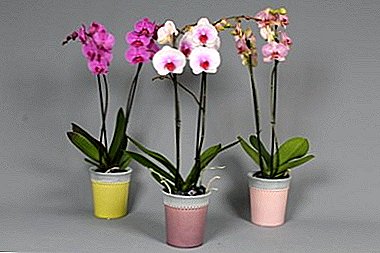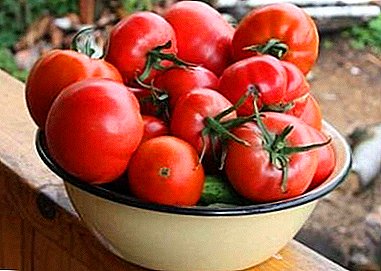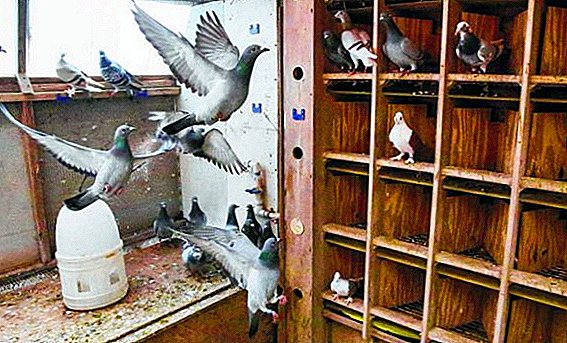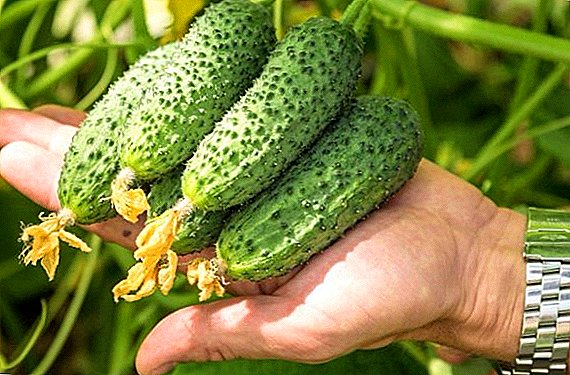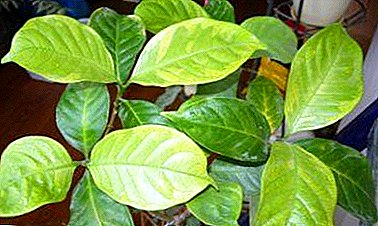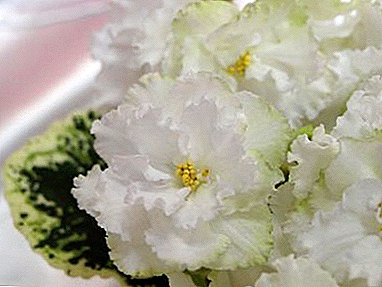 Bilbergia drooping - the most common indoor plant of all varieties of bilbergia, which received popularly the nickname "Queen's tear". How to grow such a beauty on your windowsill, especially the care and maintenance, as well as methods of breeding and pest control plants - about this in more detail in the article.
Bilbergia drooping - the most common indoor plant of all varieties of bilbergia, which received popularly the nickname "Queen's tear". How to grow such a beauty on your windowsill, especially the care and maintenance, as well as methods of breeding and pest control plants - about this in more detail in the article.
Flower characteristics
Bilbergia is a member of the Bromeliad family - plants that predominantly inhabit the tropics and subtropical zones of West Africa. This family has more than 2,000 plant species, characterized by thick, fleshy leaves and a well-developed root system.
The bromeliad family also includes plants such as aechmea, guzmaniya, vriezii and bromelia.
Among the varieties of bilbergia are found:
- green: different dark green straight leaves with gray scales. Homeland - South Mexico;

- magnificent: has upright rigid large leaves. Blooms in small blue flowers. Originally from southeastern Brazil;
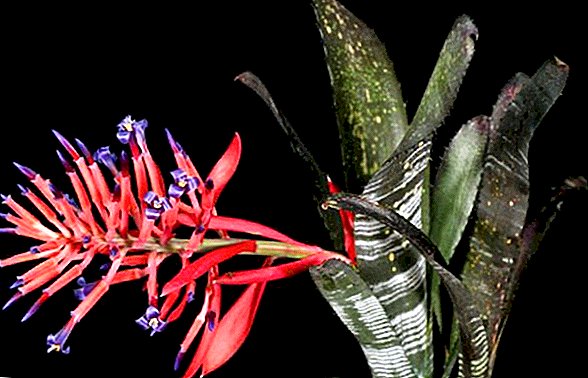
- ribbon: A characteristic feature of this variety is brightly colored leaves of various shades and large blue flowers. Country of origin - Central America;
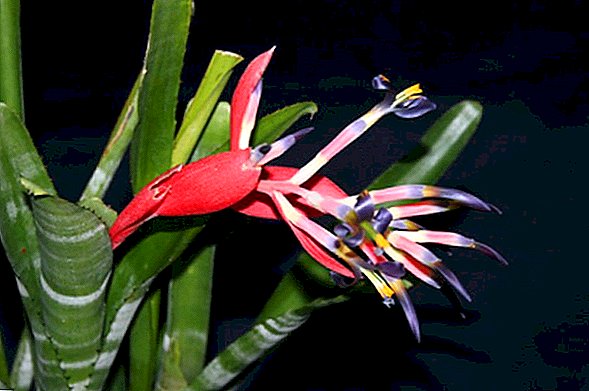
- zebra: has a silver-bronze color of leaves and bright pink flowers. Originally from Guatemala and Honduras;
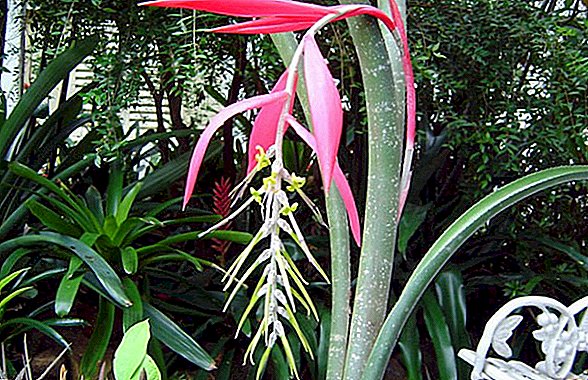
- pyramid: It is distinguished by upright twisted leaves and small flowers. Homeland - Venezuela.
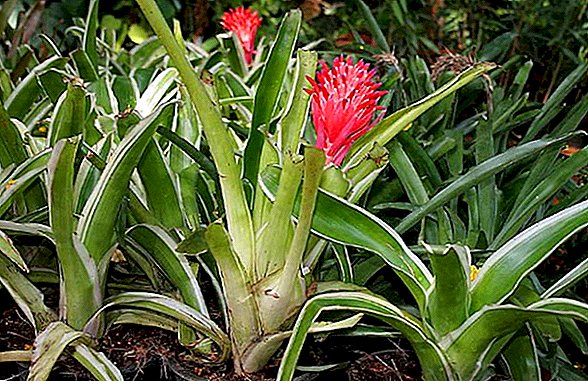
The bilbergia which is drooping (drooping) is not an ordinary plant: with Bromeliads it is related only by the strong, fleshy structure of the leaf. In all other respects, the "Tear of the Queen" rather resembles epiphytes - parasitic plants with long, bright inflorescences.
We recommend to get acquainted with various types of indoor plants.
Unlike other Bromeliads, the plant has long leaves that are narrowed to the apex - outwardly they are similar to cereals. The leaf itself is covered with small roughness or scales, and along the edge there is a series of pointed teeth. It is noteworthy that the bilbergia stem does not - the leaves grow directly from the root.
A characteristic feature of the flower is the ability to change the color of the leaves, depending on the lighting - in the dark they are dark, rich green in color, and cast a pink-bronze tint in the light. This perennial evergreen plant blooms with bright, pink-scarlet buds that set off yellow-green panicles.  The flowers are collected in twisted, spiraling drooping ears - this feature and determined the name of the plant. The flowering time of bilbergia is caused by the winter, therefore it looks especially beautiful against the background of traditional plants that bloom in summer.
The flowers are collected in twisted, spiraling drooping ears - this feature and determined the name of the plant. The flowering time of bilbergia is caused by the winter, therefore it looks especially beautiful against the background of traditional plants that bloom in summer.
Did you know? Bilbergia has a unique property - it emits special volatile substances that perfectly saturate and ionize the air. In addition, it can absorb noises or loud noises. In the practice of feng shui, the plant symbolizes spirituality and life wisdom - this is facilitated by the ability of bilbergia to create a comfortable atmosphere around itself.
However, among this plant there are such species that bloom only in summer - for example, green and pyramidal bilbergia. Flower fruit - berries. The plant reaches a height of 60 cm, and the peduncle itself can grow up to 80 cm.
Video: content and care for bilberg
Content Features
Bilbergia, despite its exotic origin, is unpretentious and undemanding plant - it perfectly adapts to a temperate climate. It is characterized by stamina and good health - this flower is rarely exposed to disease.
Undemanding houseplants also include sansevieria, chlorophytum, cactus, euphorbia, hoya, tradescantia, zamiokulkas, spathiphyllum, hibiscus, zygocactus.
However, the plant needs a comfortable temperature regime, fertilizing and appropriate watering - delayed or poor quality care can lead to death.
Air temperature and humidity
The basic rule of optimal temperature is to prevent sudden changes in temperature. A rapid change in temperature of more than 12–14 ° C causes a state of shock: the leaves wither, curl heavily, and may fall off.  Bilbergia feels most comfortable at a temperature of 17-22 ° C, and at a lower temperature (14-15 ° C), the plant blooms faster.
Bilbergia feels most comfortable at a temperature of 17-22 ° C, and at a lower temperature (14-15 ° C), the plant blooms faster.
However, if you constantly keep the flower in the cold or in a draft, you can greatly weaken the immune system of the plant, and this potentially threatens the emergence of diseases. It is also not recommended to exceed the temperature above 26-28 ° C: in case of insufficient watering, bilbergia can easily die in the heat.
Lighting
The great advantage of bilbergia is the ability to adapt to insufficient and poor light, despite the fact that the flower is by nature very light-loving. But even if your windows face the north side, and the twilight reigns in the house most of the day, the plant will quietly tolerate such a lack of light.  However, it is better to provide the flower with diffused natural sunlight: when bilbergia is bathed in sunshine, its leaves become more saturated. On summer sunny days, you can take the flower to the open air: this will accelerate the formation of young rosettes in those species that bloom in summer. It is important to ensure that the flower is not located for a long time under direct sunlight.
However, it is better to provide the flower with diffused natural sunlight: when bilbergia is bathed in sunshine, its leaves become more saturated. On summer sunny days, you can take the flower to the open air: this will accelerate the formation of young rosettes in those species that bloom in summer. It is important to ensure that the flower is not located for a long time under direct sunlight.
Watering and spraying
Over-wetting of the soil, as well as excessive aridity, can be detrimental to bilbergia - the plant prefers a medium-moisture soil. Water bilberg need no more than 1 time in 5-6 days - provided that the top layer of soil is dried out not less than 3-4 cm.
It is best to apply root watering along with spraying: in summer dry weather, you can spray a flower up to 5 times a day. In winter, watering is carried out less frequently, but not more often 1 time in 10 days.  If watering forms excess water in the pan, it must be drained: otherwise, the roots can begin to rot. During the flowering period, the top layer of soil in the pot can be covered with moss or wet clay, which will help retain moisture in the soil and better saturation of the whole flower.
If watering forms excess water in the pan, it must be drained: otherwise, the roots can begin to rot. During the flowering period, the top layer of soil in the pot can be covered with moss or wet clay, which will help retain moisture in the soil and better saturation of the whole flower.
Important! When watering and spraying bilbergia, do not allow water to stagnate in the funnel-shaped leaves of the plant — otherwise, when a draft or cold air temperature occurs, this inhabitant of the window sill will catch a cold.
Top dressing
Bilbergia needs additional fertilizer only during the vegetative period. Feed it with special soluble fertilizers intended for bromeliad species. Ordinary fertilizer can be used - however, the dose must be halved. Fertilizer is applied 1 time per 15-20 days, the whole period of feeding usually takes 2-2.5 months. 
Transfer
Regular transplantation of this tropical beauty is not needed: only when the flower has grown too much, it should be moved to a bigger pot. It is best to choose not deep, but wide pots or pots.
Plants such as Calibrachoa, Surfinia, Bacopa, Dichondra, Campanula, Begonia, Vervaina and Geranium are also excellent for planting in pots.
A new substrate is lined up in a special pot: a mixture of humus, river sand, leaf peat and soil. The prepared soil is well moistened (at this stage fertilizer can be applied), and the plant is transplanted.
Bilbergia breeding
There are several ways to propagate bilbergia: each has its own advantages and disadvantages. 
From seed
The most troublesome method of breeding a flower. For this method, best suited fresh, not dried seeds. The collected seeds are soaked in a weak solution of potassium permanganate and lightly dried. Then special containers are prepared: a mixture of wet river sand and peat is placed in them.
Prepared seeds are planted in moist soil (they need to be pressed to a depth of 1 cm). Top boxes are covered with glass or a transparent bag to achieve the greenhouse effect. These small greenhouses are exposed in a darkened warm place (with a temperature of at least 24 ° C) for 5-6 weeks - until the first shoots appear.
It is very important to constantly maintain the humidity and prevent the soil from drying out: for this, the bag or glass should be periodically removed and a good spraying of the soil should be carried out.  Propagation of bilgieria with the help of seeds is extremely rare - if you make a mistake at any stage of such reproduction, you will not be able to grow a flower, you have to wait another year until the next flowering of the plant.
Propagation of bilgieria with the help of seeds is extremely rare - if you make a mistake at any stage of such reproduction, you will not be able to grow a flower, you have to wait another year until the next flowering of the plant.
Lateral processes
A great way to get a full-fledged large plant without a long wait. In fact, the main plant is simply divided: the side processes (they are also called "kids") are simply deposited in another container.  This method is convenient in that a sufficiently large amount of such planting material is formed in bilbergia, and more than ten new ones can be obtained from one flower.
This method is convenient in that a sufficiently large amount of such planting material is formed in bilbergia, and more than ten new ones can be obtained from one flower.
"Babes" together with the roots are transplanted into small pots with prepared moist soil (it is important to provide the young shoots with a sufficient amount of sunlight). Young bilbergia can bloom only 2 years after planting.
Leaf cuttings
This method is also called "division" - the main flower is divided into parts. It is better to use a leaf stalk large, not less than 20 cm: such a leaf will have enough strength and energy to take root in a new place. The stalk must be rooted in the prepared moist soil (a mixture of peat and coarse sand).
To do this, it is planted in a small pot with a primer and covered with a transparent bag, cap or glass container on top. Next, the cutting is placed in a warm (at least 24 ° C) place with regular access of sunlight. With the support of the correct level of humidity (it is necessary to spray the cutting every 3-4 days), in a month the first roots will appear.
Pests, diseases and control measures
Despite the fact that bilbergia is a fairly strong plant with good immunity, it is not immune from the attacks of various parasites.
The main pests of the flower are:
- shield;

- aphid;
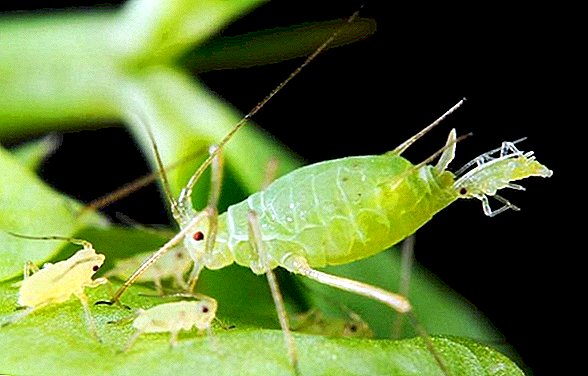
- spider mite;
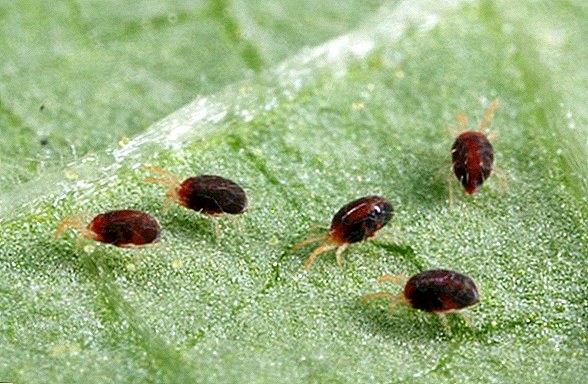
- mealybug.

To prevent the emergence of these parasites is almost impossible, however, to save the plant from pests in the shortest possible time - the duty of each grower. The affected areas of the sheet are treated with a cotton swab, which is wetted in a soap solution - they need to thoroughly wipe the entire surface of the sheet for disinfection.
If bilbergia is affected by parasites in a small amount, then usually this measure is enough for the pests to retreat. If the invasion of parasites is more widespread, it is necessary to resort to the help of an insecticide: dilute Actellic or Carbofoss in water (15-20 drops per 1 liter) and carefully spray the whole plant with this medicine.
If a fungus appears on the leaves (this often happens after the aphid invasion), the affected leaves should be removed completely, and for the uninfected to be treated with a soap solution. 
Among the most common diseases of bilbergia are the following:
- The appearance of brown spots. Most often this is the result of sunburn - in this case, the plant should be urgently removed from under direct sunlight, spray with warm water and placed in a cooler place (the temperature difference in this case should not be more than 5-6 ° C!)
- Darkening of the tips of the leaf (the ends become brown or brown). This is a signal that water stagnates in the twisted funnels of the paper, or that it is watered with too hard water: use softer water, and after spraying, wipe excess moisture from the leaves with a soft cloth.
- Wilting leaves, slow growth. Speaks about the lack of sunlight: move the plant to the open air (in summer) or use additional artificial lighting (in winter).
- Plant rotting. Serious illness that threatens to kill bilbergia. In this case, an urgent emergency transfer to a new pot with optimal soil is necessary (the moisture content of the new substrate should not exceed 50%).

In order to avoid running the disease, carefully inspect the flower every week: check the elasticity and uniformity of the leaf color, remove, if necessary, dry leaves, do not forget to apply fertilizer and monitor the soil moisture level.
Important! The rotting or drying of the flower rosette after flowering is a natural process — it is not considered a disease and does not signal that the plant becomes ill.
Why does not bilbergia bloom at home
The main reason that bilbergia stubbornly refuses to bloom is the lack of moisture and light. With regular spraying in the summer and keeping the flower in the scattered light, there are no problems with flowering. However, if bilbergia does not bloom anyway, you can try this method: put a cut apple on the pot, and put on a transparent thin bag on the flower itself.  When a greenhouse climate is created, an apple begins to secrete ethylene, a substance that accelerates the flowering process of all members of the bromeliad family (this is also the way pineapple flowering is accelerated). It is possible to acquire blooming bilbergia on your window sill by reproducing the main plant by grafting: a small plant grown in this way can bloom in a year.
When a greenhouse climate is created, an apple begins to secrete ethylene, a substance that accelerates the flowering process of all members of the bromeliad family (this is also the way pineapple flowering is accelerated). It is possible to acquire blooming bilbergia on your window sill by reproducing the main plant by grafting: a small plant grown in this way can bloom in a year.
Did you know? Plants of the bromeliad family were discovered by Columbus back in the era of the Great Geographical Discoveries. Only three centuries later, in 1815, bilbergia priramidalnaya was described in detail in English botany as a vivid representative of bromeliads. This work has several volumes and today it is in the ranks of the golden fund of botanical works.
Another possible reason for the lack of flowers on a tropical beauty is the insufficient mineralization of the soil. In this case, it is necessary to transplant bilbergia into another pot with a new, fertilized and well-moistened soil.  Bilbergia is an unusual indoor plant, which due to its bright external data can be an ornament to your flower garden. Compliance with the optimal temperature, humidity and light levels, as well as timely care will allow you to enjoy the beauty of this tropical guest for many years.
Bilbergia is an unusual indoor plant, which due to its bright external data can be an ornament to your flower garden. Compliance with the optimal temperature, humidity and light levels, as well as timely care will allow you to enjoy the beauty of this tropical guest for many years.
Reviews from the network













